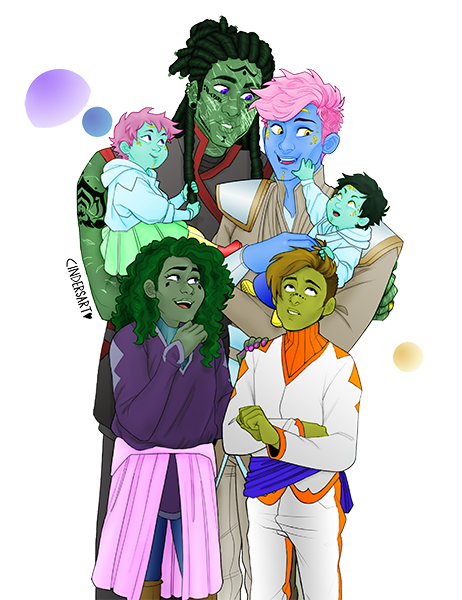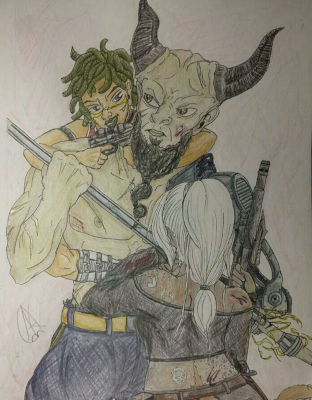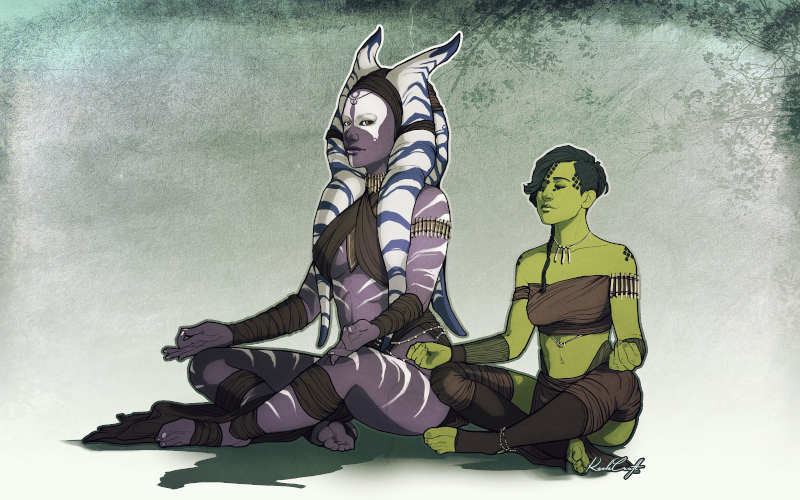Character Development
Character Development
Compelling characters make the difference between a memorable story and a forgettable one. It doesn’t matter how clever your plot is or how well-developed your world is, if the characters in that world are not interesting, the story will fall flat. In this course, we will cover the basics of character development, specifically in the context of the DB. The course will be divided by types of character: starting with the protagonist, their main enemy, the antagonist, and then the rest of the cast.
There are two sides to character development. Firstly, you need the concept and overall idea for the character, in DB terms, building a character sheet and wiki page. This course assumes that step has been done, and focuses primarily on writing your character in fiction.
The Protagonist / Main Character
The most important character in your story: if the reader doesn’t care about the protagonist, then they will not care about the story. Even a story with a simple plot and setting can be engaging if the main character is creative, interesting, and well-developed. In the DB, the protagonist of the story is probably your main character on your dossier, so this section will focus on building a strong main character that can carry you through multiple stories.
Describe them early on
I know that in the DB, we have character sheets with physical descriptions on them, and loadouts that tell the reader what the character is wearing. That is not a substitute for taking the time to describe your character in the story. It might just be one or two details, perhaps their hair, clothes, or build, layered in with some action or description of the environment. The reader needs to visualise what’s happening to have some idea of what the character looks like, ideally in the first paragraph.
Also, mention them by name early. It’s a common DB trope to avoid mentioning the main character’s name for the first few paragraphs, as if we’re adding some kind of mystery by just using pronouns and not telling the reader who we’re writing about. It’s just confusing. “Confused characters, good. Confused readers, bad.” - Brandon Sanderson.
Focus on their motivations
Consider the following three questions when you sit down to write a story: What do they want? Why can’t they have it? What do they have to do to get there?
These questions can have different answers for each story you write. But they are the core reason that your character makes the decisions they make in the story. It’s important for the reader to understand what they’re doing and why (unless you’re deliberately hiding this, in which case you as the writer should understand).
Give them a backstory
Backstories are much more compelling when the past has an effect on the present, so consider how your backstory still influences your character today. Having a 50,000-word biography on your wiki page is great, but that backstory itself doesn’t create a compelling character so much as how it informs and resonates with what they're dealing with now. Not all of your backstory is going to be relevant in every story, and that’s fine. But where possible, it can add a lot of depth to a character.
Make your protagonist protag
It’s your protagonist’s story. The story shouldn’t just happen to them; they should be the ones driving it forward. That doesn’t mean they’re always in control, but when things are out of control, it’s the protagonist who makes important choices and bears the consequences. It’s Luke who makes the decision to learn the Force, to turn his targeting computer off, to leave Dagobah early, and save his friends.
Ensure that your character has difficult decisions to make. This enables you to explore who they really are as a person. Everything is simple when you’re blasting bad guys. But what happens when blasting the bad guys puts a load of civilian lives at risk? Do they ruthlessly proceed in pursuit of the greater good, or suffer a setback due to their morality?
Make their flaws relevant
A perfect character is a boring one, we all know that, but giving your character flaws because ‘a perfect character is a boring one’ doesn’t really fix the issue. It isn’t just a box-ticking exercise of ‘character has a flaw, check, now character is interesting’. You have to use that flaw to create tension, drama, and growth. Make the flaw something that actually impacts your stories and stops them from getting to where they want to be.
Maybe your character drags out fights too long. It’s a bit overused, but it works as a flaw. If the enemy almost lands a hit because of it, who cares? The only consequence is a longer fight scene. This flaw would be much more dramatic if dragging out the fight leads to the endangerment of a close ally. Maybe their relationship is fractured, creating conflict. Do they apologise or stick to their guns? What if the ally dies? How do they deal with that? Do they try to address the flaws? This puts the character flaw at the forefront of the story, rather than just being an afterthought because you wanted an aspect approved.
Consider creating a character arc
A character should grow with the story. If your character comes out of the story the exact same person as they started, what was the point of the story? A character arc doesn’t have to be a positive change. Throughout Revenge of the Sith we see Anakin Skywalker go from a celebrated war hero to a child-killing Sith Lord. In the Breaking Bad, we see the main character progress from being a kind high school science teacher to using his knowledge for making and selling methamphetamine. In the DB, we tend to write many short stories about our characters, and if every one resulted in huge changes to the character, our stories would become very disjointed. But change can be gradual over many short stories.
It is worth mentioning that not every character needs a character arc to be compelling. Sherlock Holmes is one of the most famous characters in fiction and is largely the same in every story.
The Antagonist
Antagonists in the DB
When we write in the DB, our antagonists are often picked for us: the Collective, the Children of Mortis, etc. But that doesn’t mean we can’t create our own. In a Great Jedi War, your clan might be fighting the Collective, and the Collective comes with a bunch of NPCs, but you can still create your own that fit your story better. Storytelling is a form of creative writing. So create things. Make an antagonist that is fitting to share the stage with that protagonist you’ve spent so long crafting. This section applies to leaders designing antagonists for their members as much as it does members writing everyday DB fiction.
Determine their power level
In most traditional fantasy stories, the antagonist possesses more power than the protagonist, who often has very little. Sauron and Voldemort are all-powerful dark sorcerers, which makes the reader wonder how the hero is going to win against such a powerful foe. Even just within Star Wars, the list of powerful antagonists is endless: just look at any character with Darth in their name. In the DB, it can be helpful to give them a sandbox character sheet, maybe a rank or two above your own. If the protagonist can just outpower their opposition, where’s the tension?
Although most stories present their protagonist with a more powerful foe, it is possible to build a compelling antagonist without making them more powerful than the protagonist, as long as you:
Match their skills against the protagonist
Your character might be beyond compare in shooting people. But what happens when shooting people isn’t an option, and the antagonist strikes from the shadows? The Joker movies were masterful at this. Batman was far more powerful than the Joker, in terms of his combat abilities and his resources, yet the Joker is one of the most popular villains in movie history. The Joker is dangerous because he attacks with intelligence and precision, and the Dark Knight, despite all his resources and power, has no answer to it.
The antagonist must pose a real threat to the protagonist; otherwise, there is no tension. When building an antagonist, make them strong where your protagonist is weak.
What are their Motivations
Very few people see themselves as evil. Many are the protagonist of their own story. Having a villain who believes they’re in the right can add a level of complexity to your plot, can create conflict with the main character and even with the reader, if they have good reasons for taking their actions.
It’s important to note that not every story needs a morally ambiguous villain. You can create a compelling story with an antagonist that is just pure evil. Voldemort gets criticism for being pure evil, and his main motivation for seven books is to murder a child. For me, he still works as a compelling villain purely for the fear he evokes. Some stories are just simply good vs evil. And there’s nothing wrong with that. The most important thing is that we understand why the villain is doing what they’re doing, because it’s often their actions that set up the core conflict of the story. Voldemort wants to kill Harry because he wants to become immortal. His actions are entirely consistent with his core motivation.
What Impact do they have on the Protagonist?
Another thing to consider when developing a compelling villain is what effect they have on the main character. What choices do they force the protagonist to make? How do those choices develop internal conflict in your protagonist? In the Dark Knight example, Batman's internal conflict is whether being Batman is worth it. The Joker plays and exacerbates that internal conflict, which adds a lot of depth to their interaction. Consider whether you want your villain to be an obstacle to overcome, or really get inside your protagonist’s head, forcing them to make difficult choices and face their inner demons.
Other Characters
The Supporting Cast
It’s fairly rare for effective fantasy/sci-fi stories not to feature a group of supporting characters. Luke Skywalker has Leia, Chewie, and Han. Harry Potter has Ron and Hermione. Frodo has Sam, Merry, and Pippin. If there’s only one character in the story, things can get dull fairly fast.
When designing supporting characters, consider how they might interact with your main character. Do they agree on everything? Or would there be significant sources of disagreement within the group of protagonists that lead to conflict?
Common Ensemble Fiction Frameworks
The Power Trio: Fighter, mage, thief. Tank, dps, healer. Balance, speed, strength. A power trio consists of three characters bringing different skills/perspectives to the table. We often see our protagonist offering something of a balance, with the other two members offering them different options. The most famous example in modern media is the trio in Harry Potter, where Ron offers street-smarts, Hermione offers book-smarts, and Harry is in the middle.
The Five-Man Band: Hero/leader, lancer, heart, brains, brawn. This is, most conveniently, the number of characters we have available in the DB. In Star Wars, we have Luke as the hero, Han as the lancer, Leia as the heart, Obi-Wan as the brains, and Chewbacca as the brawn. The five-man band can be more difficult to write because it’s easier to lose track of characters, and mentioning all of them all of the time can feel clunky and awkward.
Minor characters
Don’t assume that just because a character only appears on one page, they have to be flat and one-dimensional. Your character wants to stay in the hotel, but they don’t have money. For the hotel clerk, they are the protagonist, protecting their business. They have a personality. Vibrant worlds jump out of the page when they are populated by people who act like people, have distinct personalities, goals, and take steps towards those goals, and that’s as true for the guy in space traffic control who clears your ship for takeoff as it is for your main character.
Image Credits:
Ruka and Corazon Ya-ir lineart by Cindersart, commissioned and coloured by Ruka Tenbriss Ya-ir
Zujenia and Diy fighting Kerwin Drake by Diyrian "Diy" Grivna
A’lora Kituri and Oriana by Kaela Croft, commissioned by A'lora Kituri
Please log in to take this course's exam


